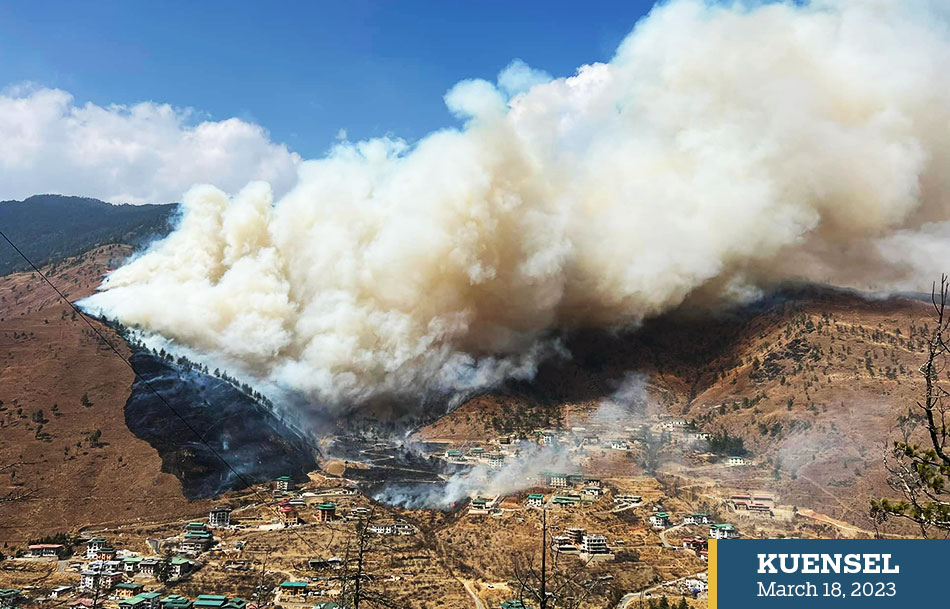In the wake of recent fire disasters in Bhutan, the article is aimed at creating awareness of threats of fire to drinking water systems. Both wildland fire (Debsi fire) and fire damage to residential (Changjiji) and water infrastructure could potentially generate toxic contaminants posing a significant risk to public health. Forest fire generates fire-derived organic matter, which could interfere with water treatment processes, while urban fires like Changjiji burned infrastructure, electronics, plastics, and other artificial materials, generating a variety of toxic chemicals in our drinking water systems. The use of fire extinguishers further increases pollution risk through the use of hazardous PFAS chemicals also dubbed as ‘forever chemicals. Most of these hazardous chemicals persist in the environment for long-term, while they also bio-accumulate and most of them cause cancer. The use of other fire retardants and suppression agents like ammonium sulphate and ammonium phosphate also release nutrients, including inorganic nitrogen and phosphorus, into source waters.
Fire damage to the residential water supply network like in the case of the recent fire in Changjiji could also potentially contaminate drinking water with benzene, polycyclic aromatic hydrocarbons, and other volatile organic compounds (Tshering et al. 2023). For example, up to 40 milligrams per liter of benzene was reported in water distribution lines following the fire in urban California (Proctor et al. 2020).
Similarly, a wildland fire like the one in Debsi would have also damaged the water distribution pipelines given an unprecedented amount of localized heat energy generated by the firefront. The damage to water distribution pipes and plastic storage tanks would generate similar nature of toxic chemicals as in the case of the Changjiji Fire. For example, when wildfires swept through the hills in urban California, in 2020, the regulators found hazardous benzene, a carcinogen, at 40 times the state’s drinking water standard. Such high levels of contamination are comparable to hazardous waste. Further, in some cases, Benzene concentration was found at a level 8,000 times the US federal drinking water limit and 200 times the level that causes immediate health effects. The immediate ill-health effects of the chemicals include dizziness, headaches, skin and throat irritation, and even unconsciousness, among other risks (Andrew et al. 2020), while they are known to cause cancer in long-term.
Large-scale fires in a forested catchment like the recent Debsi fire would also generate a significant amount of fire-derived organic compounds in the burned area and nearby environment. The fire-derived organic compounds itself is not a contaminant with direct impacts on human health, but it creates problems for water treatment processes. It can cause discolouration, affect tastes, serve as a substrate for unwanted microbial growth, and reduces the efficiency of all kinds of filter systems – domestic or commercial. Fire-derived organic compounds can increase treatment costs and chemical demand levels. In addition, chemical treatment of fire-affected waters often introduces unintended side effects: Disinfection processes can form a variety of carcinogenic chemicals like disinfection by-products (DBPs), which are strictly regulated worldwide as they are known to cause cancer and permanent damage to genes in animals and humans alike (Chow et al. 2021).
Although wildfires can destroy forest ecosystems within days, fire-derived contaminants can persist in burned landscapes for decades. The fire-derived toxic compounds were known to remain in the local water system for a few years to more than 16 years (Chow et al. 2021). How long will such toxic compounds last or the nature of contaminants in Debsi or Changjiji water distribution network are currently unknown.
Further, the risk of drinking water contamination increases when the rainy season starts. Rainfall after a fire enhances the leaching and transfer of contaminants from burned residues, and it can also transport lightweight ash to nearby surface waters. This deposition raises levels of organic contaminants, heavy metals, and total suspended solids; increases turbidity, and lowers dissolved oxygen levels in the water, potentially killing aquatic organisms (Tshering et al. 2023).
According to the research by Andrew et al. 2020, the following key measures need to be implemented immediately after the fire:
· Identify signs of potential contamination such as loss of water pressure, water discolouration, heat damage to water systems inside and outside buildings, and broken and leaking pipes, valves, and hydrants.
· Once a system is contaminated, clean-up can take months. The water system will have to be flushed and tested regularly to track down contamination. Single-rinsing heat-damaged pipes may not always remove the contamination, for example, USA Environmental Protection Agency found that some burned plastic pipes required more than 100 days of nonstop water rinsing to be safe for use. Thus, drinking water in fire-affected areas should be assumed to be chemically unsafe until proven otherwise.
· Both hot and cold water systems in the residential buildings need to be sampled for any post-fire contamination investigations. Before collecting a water sample, the water must sit long enough in the plumbing so contamination can be found. While the water quality tests should look for more than a common contaminant like benzene!
· To reduce the spread of contamination the damaged pipes need to be quickly isolated. For example, benzene contamination in the water distribution system after the Santa Cruz fire (USA) was contained by blocking water distribution system valves.
· Researchers recommend testing both surface and groundwater, and water in service lines in fire-affected areas. If contamination is found, finding and removing the heat-damaged plastic contamination sources are recommended. Some plastics can slowly leach chemicals like benzene over time, and this could go on for months to years.
The article is published based on personal experiences and observations by a group of water researchers from Bhutan. The group can be contacted at waterresearchbhutan@gmail.com


